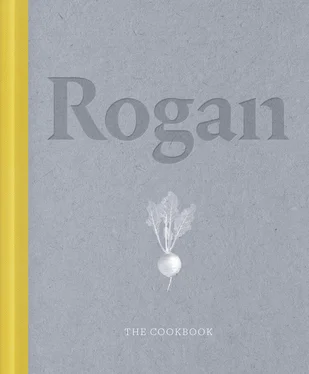Meanwhile, confit the potatoes. Put all the ingredients in a medium, heavy-based saucepan over a low heat and cook slowly for about 2 hours until the potatoes are tender.
Meanwhile, make the purée. Cook the shallots in the oil and butter in a large, heavy-based saucepan over a low heat for 35–40 minutes, stirring regularly. When the shallots have turned a deep golden colour, strain them, pouring off and reserving the ‘onion oil’. Blitz the drained shallots with the milk in a blender until smooth. Pass through a fine sieve, season with salt and leave to one side.
Blend the blackened dried onions and maltodextrin, if using, into a powder, then stir in the ‘onion oil’ to make the ash a little clumpy. Put to one side.
To make the emulsion, bring a large saucepan of water to the boil and blanch the parsley and lovage leaves for 1 minute. Scoop them out with a slotted spoon and refresh in a bowl of iced water. Drain, squeeze out the excess water and blitz the herbs with the oil in a blender until smooth. Pass the herb oil through a muslin-lined sieve. Blitz the soft-boiled eggs in a clean blender on medium speed, adding the lovage oil slowly until the emulsion has a mayonnaise consistency; season with salt.
Spoon dots of shallot purée on to a serving dish and sit the drained warm potatoes on top. Spoon a small amount of lovage emulsion on each potato and scatter over the onion ash.
BABY POTATOES WITH OX-EYE DAISY SPREAD AND CULTURED CREAM
In June you will see ox-eye daisies everywhere – along roadside verges as well as in domestic gardens. These yellow-centred white flowers grow like weeds, so there’s no problem with foraging a few flowerheads for this dish. The flower buds are pleasingly aromatic and perfect for flavouring savoury vegetable dishes. Cultured cream is fermented crème fraîche, so including this helps you to stock up on good bacteria in your digestive system. The cultures take 4 days to activate, so you need to plan ahead, and make sure you use live culture crème fraîche to ensure proper fermentation.
SERVES 6, AS A STARTER
Cultured cream
250g double cream
40g crème fraîche
Ox-eye daisy spread
1 carrot, chopped
1 beetroot, chopped
1 onion, chopped
2 garlic cloves, chopped
50g unsalted butter
1 tbsp plain flour
2 handfuls of ox-eye daisy
1 handful of mugwort
1 tsp ground ginger
juice of 1 lemon
1 tbsp tomato purée
Baby potatoes
350g baby potatoes
1 tbsp salt
Maldon sea salt and freshly ground black pepper, for seasoning
pea shoots, borage flowers, rapeseed oil, to serve
To start the cultured cream, warm the cream in a small, heavy-based saucepan over a low heat until it reaches 34°C (check with a thermometer). When the temperature is reached, remove the pan from the heat and stir in the crème fraîche. Transfer the mixture to an airtight container and leave for 3 days at room temperature, then transfer to the fridge for 1 day.
Heat a large, heavy-based saucepan over a medium heat. Cook the carrot, beetroot, onion and garlic in the pan with the butter and a pinch of salt, stirring regularly, for 10–12 minutes until tender. Sprinkle in the flour, stir it into the vegetables and cook for a further minute. Add the rest of the ingredients, along with 20ml water, and cook for a further 5 minutes, stirring at regular intervals. When almost all the liquid in the mixture has evaporated, remove from the heat and blitz with a hand-held blender until smooth. Pass through a fine sieve. Keep warm.
Put the baby potatoes in a medium saucepan with the salt and cover with cold water. Cook over a medium heat for 10–12 minutes, or until tender, then drain.
Smear ox-eye daisy spread on each plate, add dollops of cultured cream and set the warm potatoes on top. Season with Maldon sea salt and freshly ground black pepper, sprinkle with pea shoots and borage flowers and drizzle with rapeseed oil.
DOCK PUDDING WITH RAMSON EMULSION
In Cumbria this is traditionally eaten at Easter and is better known as Lent pudding. It is eaten at this time of year because supposedly this combination of fresh spring herbs cleanses the system of the fats eaten during the winter. The flavours are fresh and aromatic; acidic dock and herby, vegetal nettles are accentuated by the garlicky hit from the ramson emulsion. This recipe is a forager’s dream; nettle, dandelion and dock leaves grow across the country throughout most of the year, but ramsons, also known as wild garlic, have a short season in late spring, so make plenty of emulsion then, as we do, when ramsons are available and freeze it for use over the next few months.
SERVES 4, AS A STARTER
Dock pudding
200g pearl barley
6 Savoy cabbage leaves
10g nettle leaves
5g dandelion leaves
5g dock leaves
2 tbsp sunflower oil
½ onion, diced
1 leek, thinly sliced
75g porridge oats
2 hard-boiled eggs (cooked for 8 minutes)
Dock pudding crumb
250g panko breadcrumbs
5g dock leaves, dried
5g ramson leaves, dried
4 eggs, beaten
200g plain flour
Ramson emulsion
100g flat-leaf parsley leaves
20g ramson leaves
200ml sunflower oil
2 soft-boiled eggs (cooked for 4 minutes)
salt, for seasoning
vegetable oil, for deep-frying
First, make the dock pudding. Cook the pearl barley in 1 litre of water in a medium saucepan over a medium heat for 25 minutes until soft and tender. When cooked, rinse under cold running water to cool, then leave to drain.
Bring a large pan of salted water to the boil and blanch the cabbage leaves for 2 minutes, then remove them with a slotted spoon and refresh them in a bowl of iced water. Drain and squeeze out the excess water. Repeat with the nettle, dandelion and dock leaves, blanching them for 1 minute each. Slice all the blanched leaves thinly and leave to one side.
Warm the oil in a large, heavy-based saucepan over a medium heat, add the onion and leek and sweat for 3–5 minutes, or until translucent. Add the cooked pearl barley, blanched leaves and porridge oats, stir well and cook for a further 2 minutes. Remove from the heat. Grate the hard-boiled eggs and add them to the mixture. Taste, season with salt and leave to one side to cool, then roll the mixture into golf ball-sized balls and chill.
To coat the dock pudding, blitz the breadcrumbs and dried leaves together in a blender to form a powder and put in a shallow dish. Put the beaten eggs in another shallow dish, and the flour in a third dish. Roll and coat the dock pudding balls first in the flour, then the egg and finally the breadcrumbs.
To make the ramson emulsion, blitz the parsley, ramsons and sunflower oil in a blender until smooth. Strain through a muslin-lined sieve and put straight into the fridge to chill. In a clean blender, blitz the soft-boiled eggs on medium speed. Add the green oil slowly until the emulsion has a mayonnaise consistency. Strain through a fine sieve to create a smoother texture and season with salt.
Deep-fry the dock pudding balls in batches in a pan of oil heated to 180°C until crisp and lightly golden, removing with a slotted spoon and leaving them to drain on kitchen paper. Serve with the ramson emulsion.
HALF-DRIED TOMATOES WITH ROSEHIP, MINT AND BONE MARROW CRUMB
Bone marrow is a much-neglected cut of beef shin, which is a shame because it gives a big protein hit and has an intense umami flavour. I’ve included rosehips here for their wonderfully fragrant aroma, and because I often forage for them near my home, so I’m always trying new ways to use them. For the best flavour, infuse the hips in the syrup for 24 hours. This recipe produces a lot of syrup, but it stores well and can be added to granola and yoghurt, drizzled over ice cream or tossed through summer berries.
Читать дальше












